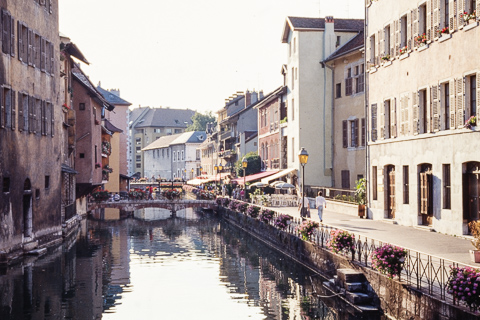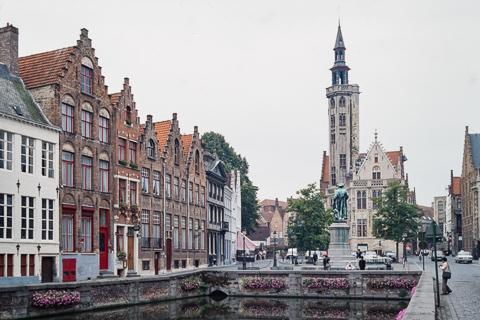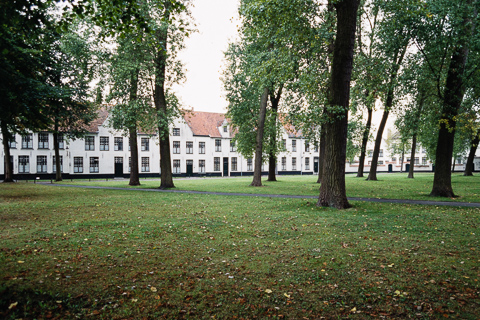Revitalization of the historic cityscape
The European city I visited was impressive with the cityscape that still retains the history from the 10th century. The feature is that it not only creates a cityscape of flowers, but also preserves historic buildings and nature. I would like to talk about preservation of historic buildings and revitalization of historic cityscape in Annecy (France) and Bruges (Belgium), where the beauty of flowers, historic buildings, water (lakes, canals, etc.) and greenery was very impressive.
ANNECY
Annecy (France) is a castle town that has prospered around Annecy Castle since the 12th century. It is a mountain and lake resort city with Lake Annecy, France's largest natural lake, and a canal called Chu that connects to the lake. Since it is near the Alps, the ski industry is concentrated nearby, and it is a sister city of Hakuba Village in Japan. The appearance of the old town facing the canal is also called Venice in France, but the beautiful and clean cityscape with well-arranged flowers is unique to this city. Houses of 3 to 5 stories are lined up on both sides of the narrow cobblestone road in the Middle Ages. Masonry walls and steep roofs with scaly roof tiles are characteristic of medieval Central Europe.
The entire old town is a pedestrian paradise, and people can enjoy walking along the cobblestone streets. The building is decorated with flowers
The canal that runs through the center of the city is the main character that decorates the city with flowers. The hard function of the canal is now abandoned, but the soft value of water itself, such as its comfort and freshness, is a valuable asset in modern times. In addition to actively preserving the canal, the city makes full use of its value with more than 1000 planters lined up by the water to make the city look gorgeous. On the stone bridge over the canal, a crowded market was held on the day of my visit. At night, the canteras set up everywhere along the canal are lit, matching the masonry buildings and creating a very romantic atmosphere. It is a city that can be visited in a few hours from Geneva. I heard that JTB's honeymoon tour started on a trial basis from this year, and I hope that it will become popular as a wonderful city.
The old town is only a small part of a large city with a population of 50,000, but the flower and green oasis that connects canals, parks and Lake Annecy plays a major part in enriching the lives of the people of the city. It is a cityscape that makes full use of the history and cultural heritage that should be preserved, and the nature of the vast mountains and lakes. I was strongly impressed by the fact that it makes me feel the "identity of the city", which is completely unrelated to the uniform, non-individual city that is often developed in Japan. I was reminded of the important basics of cityscape building.
BRUGES
Bruges (Belgium) is a commercial city with a population of 120,000, located on the northern tip of the European continent. In the 12th century, it has a history of prosperity that surpasses Paris and London in the trade of diamonds and the wool industry. The area around the city is surrounded by canals, and the outer circumference is green. The building features brick exterior walls and steep roofs, and the stepped silhouette of the gable wall accents the townhouse-style cityscape. Perhaps because of the high latitude, it seems that the cityscape is being built with a focus on green conservation rather than flowers.
The Markt Square in the center of the city and the Gothic buildings that surround it make us feel the history, but the characteristic of the cityscape is rather the small parks scattered in the city. As a remnant of the Middle Ages, there are about 30 monasteries remaining in the city, but the city is actively purchasing these monasteries and using them as a base for greening the city. The monastery, which is no longer in use, will be dismantled and the site will be provided to the citizens as a park. As a result, green spaces, flower beds and public parks can be found throughout the city. In addition to the ruins of the monastery, the city manages the garden of the private mansion and the ruins of the station, and uses it as a place for citizens to relax. These cityscapes can be seen from the bell tower (88 meters high) on the Markt Square. It is a medieval cityscape with stones and bricks, which may have a cold and stiff image, but we can see a gentle sight dotted with greenery.
It seems that the city regulates signboards, neon lights, etc. so as not to spoil the atmosphere in the city, and gives guidance to buildings to retain the traditional shape of the Middle Ages. The method of regenerating a building which mission has been completed into a space of relaxation for the citizens, thereby creating a space for the cityscape and living value, is one of the wisdoms of revitalizing the historic cityscape and achieving nature conservation. In particular, this city has a wide width road, which is unusual for a city from the Middle Ages, and by providing more open space there, the unique "comfort and richness of the city" can be strongly impressed. After all, Having a good understanding of the history of there own city and greening it unique to this city, which cannot be imitated anywhere else, is the source of achieving a high level of cityscape creation.
Conclusion
Revitalization of the historical cityscape can be said to be the creation of a cityscape that cherishes the "roots of the city" and clarifies the "identity of the city". It is not just the attitude of leaving the old heritage, but it is important that the maintenance of the heritage is not a burden and is accepted by the residents with a favorable impression. The success of creating these two cityscapes is that they have wisdom to distinguish between what should be left and what should be regenerated, and they have been able to create amenities that are indispensable for the lives of citizens through the historical heritage of each city.




